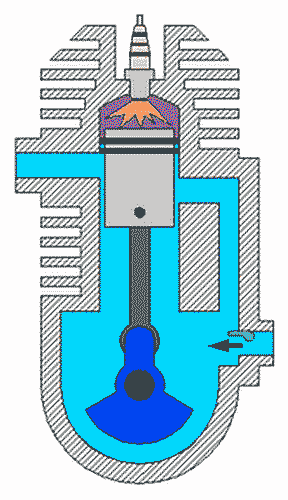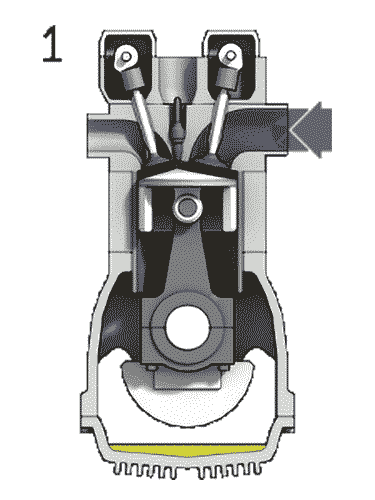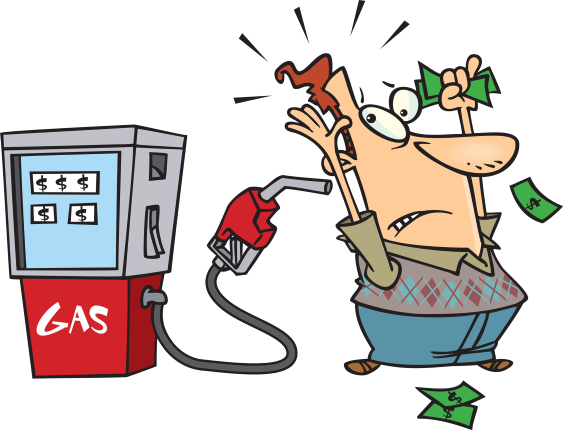2-cycle vs 4-cycle Lawn Mower: Which is Better?
Table of Contents
It can be a difficult choice when you are looking for a new mower. The first decision is what kind of machine you are going to get. There are basically only two internal combustion engines on the market four-stroke engines or two-stroke engines. ( I will use both the terms cycle and stroke here as they both mean the same thing)
2-cycle lawn mowers have been on the market for longer and there are a lot of these machines around. They are not as heavy as a 4-stroke gasoline engine and are usually a bit cheaper too. However, these small engines do need you to premix 2-stroke oil in with the fuel and this can be a bit annoying. These machines also produce more pollution than a 4-stroke.
4-cycle lawn mowers are a more recent addition to the market but they are growing in popularity. You can run the machines on straight gas which makes things easier and they produce less pollution so that’s a win-win right there. However, they do tend to be more expensive than 2-stroke lawn mowers.
So which one is better 2-cycle vs 4-cycle?
It depends on what you are looking for. A 2-cycle is lighter and cheaper and that could be a good option for you. But if you are looking for something more powerful and you don’t want to bother with fiddling around getting the mix ratio right, before tipping it into the fuel tank then a 4-cycle may be the one for you.
Still, before you rush out and buy a machine, let’s have a look at what is so different about these two engine types
Comparing the Performance of a 2-cycle vs 4-cycle
To help you decide we would need to have a closer look at 2-cycle vd 4-cycle engines and see how they perform against each other.
A 2-cycle engine is smaller and weighs less and this makes them easier to handle on difficult lawns. They have more pick-up and tend to have a higher power-to-weight ratio.
4-cycle engines have a lot more power and are better when you are doing harder jobs such as overgrown lawns and reclaims. They are more expensive and require more maintenance but most users think that they are worth it.
Piston Movements
The Two-stroke Engine How it Works

Just imagine a bicycle. When you start pedaling you move forward, right? Now let’s compare it to a 2 stroke engine. Like a turbocharged bicycle. In this type of engine, there are two movements or strokes. The first one is called the “power” stroke, where all the magic happens. It’s, like when you push down hard on the pedals while riding your bike. That’s similar to the power stroke in an engine.
During this stroke, a mixture of fuel and air ignites and forcefully pushes a piston (think of it as a metal plunger) down within the engine. After that push, it’s time to prepare for the one. Which is where the “exhaust” stroke comes in. Picture lifting your foot off the pedal to get ready for another push; similarly during the exhaust stroke in an engine all the remaining burned gases from combustion are expelled to create space, for fuel and air needed for the power stroke.
Essentially it becomes a cycle of pushing (power stroke) and preparing (exhaust stroke) happening repeatedly to ensure smooth operation. That’s essentially how a 2 stroke engine dances its way through!
The Four-stroke Engine How it Works

Let’s stick with our bicycle analogy for a moment.
A 4 stroke engine can be compared to a systematic way of pedaling.
- Intake: Think of it as taking a breath before you start pedaling. In the engine, this is known as the stroke. The engine opens a valve allowing a mixture of fuel and air to enter.
- Compression: Now imagine compressing your breath, inside your chest as you prepare to push the pedals down. Similarly, the engine compresses the fuel-air mixture to make it potent and ready for combustion.
- Power: This is where the real force comes in! Like when you press down on the pedals with strength the engine ignites the compressed mixture leading to a controlled explosion. This explosion drives the movement of the piston downward generating power.
- Exhaust: After delivering that push it’s time to release what has been used up. Picture exhaling after exerting yourself while pedaling. The engine opens another valve to expel the burnt gases making room for the cycle.
Essentially it’s, like following a four-step dance routine; inhale (intake stroke) compress (compression) exert force (power) and exhale (exhaust). If you repeat this process you’ll hear the rhythm of a 4 stroke engine!
Exploring 2-Stroke Engines
Let’s dive into the world of 2 stroke engines. When it comes to lawnmowers there are two types of engines; the 2-stroke and the 4-stroke. In this section, we’ll take a look, at the features of a 2 stroke engine.
To make a 2 stroke engine work you need to combine gasoline and oil. Unlike a 4-stroke engine that stores oil separately for lubrication purposes in a 2-stroke engine, the oil needs to be mixed with the fuel. The specific ratio may vary depending on the manufacturer. Is typically around 50 parts gasoline to one part oil.
So how does a 2 stroke engine actually operate?
It starts by blending air and fuel in the carburetor compressing this mixture within the cylinder igniting it with a spark plug and then expelling the resulting exhaust through an exhaust port. This entire process occurs within two strokes of the piston—thus earning it its name as a “2 stroke” engine.
Due to their size and lighter weight compared to their counterparts, 2-stroke engines are often preferred for equipment, like a weed eater or string trimmers.
They are also famous, for their power-to-weight ratio making them a popular choice among dirt bike enthusiasts and users of outdoor power equipment.
Understanding 4-Stroke Engines
4-stroke engines can typically be found in lawnmowers and other lawn equipment. They are also referred to as 4-cycle engines. These engines offer fuel efficiency emit pollutants operate with less noise and have a longer lifespan compared to 2-stroke engines. However, they tend to be heavier more intricate in design, and require maintenance than their 2 stroke counterparts.
A 4 stroke engine operates through four piston strokes; the stroke, compression stroke, power stroke, and exhaust stroke. During the stroke, the engine draws in a mixture of fuel and air through the valve. As the piston moves upward during the compression stroke it compresses this mixture which raises its temperature and pressure. The power stroke is ignited by the spark plug which causes an explosion within the fuel-air mixture. This explosion drives the piston to generate power. Finally, during the exhaust stroke, the exhaust valve opens allowing for the expulsion of exhaust gases from, within the engine.
Lawnmowing101 Membership

Build a six-figure lawn care business
Lawn Care Software

Get Your Lawn Care Business Running Smoothly
Easier for you and your customers. Jobber helps you quote, schedule, invoice, and get paid—all in one place.
What type of oil do I need for a 4-stroke lawnmower?
with a 4-stroke engine? 4-stroke engines have compartments for oil and fuel so there’s no need to mix oil with gasoline. You should use the type of oil that the manufacturer recommends for your lawnmower engine. Generally, 4-stroke engines require either SAE 30 or 10W 30 motor oil. You can find the recommended oil type in the owner’s manual of your lawnmower or on the manufacturer’s website.
Regularly changing the oil in a lawn mower engine engine is important to avoid engine damage and extend its lifespan. It is suggested to change the oil after every five hours of use and then every 50 hours of use or once a year whichever comes first. Additionally, make sure to check the oil level before each use and add more if necessary.

What are the differences between 2-stroke and 4-stroke lawnmowers?
In terms of lawnmowers, there are two types of engines; 2 stroke and 4 stroke. The main distinction, between them lies in how many strokes it takes to complete a power cycle.
In a 2 stroke engine, the piston completes a power cycle in one rotation of the crankshaft whereas in a 4 stroke engine, it takes two rotations of the crankshaft to complete a power cycle.
Here are some additional contrasts, between lawnmowers equipped with 2-stroke and 4-stroke engines;
Fuel and Oil
One notable distinction between these two types of engines lies in their fuel and oil consumption. 2 stroke engines rely on a gasoline oil mixture for operation while 4-stroke engines solely utilize gasoline. Consequently, 2-stroke engines necessitate refuelling and oil changes compared to their 4-stroke counterparts.
Power and Efficiency
Although 2-stroke engines tend to possess more power output than similar-sized 4-stroke engines they sacrifice fuel efficiency. This discrepancy arises from the fact that 2 stroke engines burn a fuel oil blend which is inherently less efficient than burning gasoline alone. Conversely while being more fuel-efficient overall 4 stroke engines tend to be less powerful.
Maintenance
An additional distinguishing factor between these engine types is the level of maintenance required. Due to their design, with moving parts, 2 stroke engines. However 2 stroke engines necessitate oil changes and spark plug replacements.
Which type of lawnmower is more fuel-efficient?
According to Garden Tool Expert, one of the reasons why 4-stroke engines prove to be more fuel efficient is their ability to burn fuel in a more complete manner. This results in reduced wastage of fuel which subsequently leads to overall fuel economy.
Furthermore thanks to a size, to power ratio compared with their 2-stroke counterparts, 4-stroke engines can generate power output while utilizing less amount of fuel.
However, it’s worth noting that the fuel efficiency of a lawnmower depends on factors. These factors include the size of the engine the type of fuel used and the condition of the lawnmower. For instance, even if both have 4-stroke engines a lawnmower, with an engine may be less fuel efficient compared to one.
To summarize in terms of fuel efficiency 4-stroke lawnmowers are generally better than a To summarize in terms of fuel efficiency 4-stroke lawnmowers are generally better than 2-stroke ones because they have combustion efficiency and a favourable size-to-power ratio. Nevertheless, it’s important to consider factors like engine size and fuel type as they can also impact fuel efficiency. because they have combustion efficiency and a favourable size-to-power ratio. Nevertheless, it’s important to consider factors like engine size and fuel type as they can also impact fuel efficiency.

Is One Type of Lawnmower Better for Larger Lawns?
When it comes to mowing lawns the choice of lawnmower can significantly influence efficiency. While both 2-stroke and 4-stroke lawnmowers can be used for lawns there are some distinctions to take into account.
There are a few benefits, to opting for a 2-stroke lawnmower. One advantage is its weight and compact design, which sets it apart from the bulkier 4-stroke models. This feature comes in handy when navigating through lawns making it easier to move and transport the mower.
What are the benefits of using a 4-stroke lawnmower over a 2-stroke lawnmower?
There are advantages that 4 stroke lawnmowers offer compared to their 2 stroke counterparts.
1. Improved fuel efficiency
When it comes to fuel consumption, 4-stroke engines are known to be more efficient compared to 2-stroke engines. They can generate the amount of power while using fuel wisely. The reason, behind this, lies in their design, which includes compartments, for fuel and oil.
2. Environmental friendliness
In addition to their fuel efficiency 4-stroke engines also tend to produce emissions compared to their 2-stroke counterparts. This makes them a greener choice that contributes positively to the environment.
3. Extended engine lifespan
4-stroke engines generally have a lifespan compared to their higher rpm 2-stroke counterparts. This can be attributed to the design of 4-stroke engines, which enables them to operate at lower RPMs. Consequently, they experience wear and tear over time.
4. Quieter operation
4 stroke engines tend to be less noisy compared to 2 stroke engines. The reason, behind this is that 4 stroke engines have a number of components, which aids in minimizing the noise levels.
5. Increased torque
When it comes to torque production, 4-stroke engines outperform their 2-stroke counterparts due, to their displacement capacity. This enables them to generate power.
Summing up
individuals seeking fuel efficiency, environmental friendliness and reliability would find that opting for lawnmowers equipped with 4-stroke engines is advantageous. However, it’s important to note that these engines tend to be heavier and more complex while also requiring maintenance when compared with their 2 stroke counterparts.
Read more Are all lawn mowers 4 strokes?
Listen to audiobooks while you work.

With a sixty-day free trial
Discover millions of ebooks, audiobooks, and so much more for just $9.99/month.
Get tips & tricks on how to grow a profitable lawn care business delivered to you inbox every week.






Leave a Reply